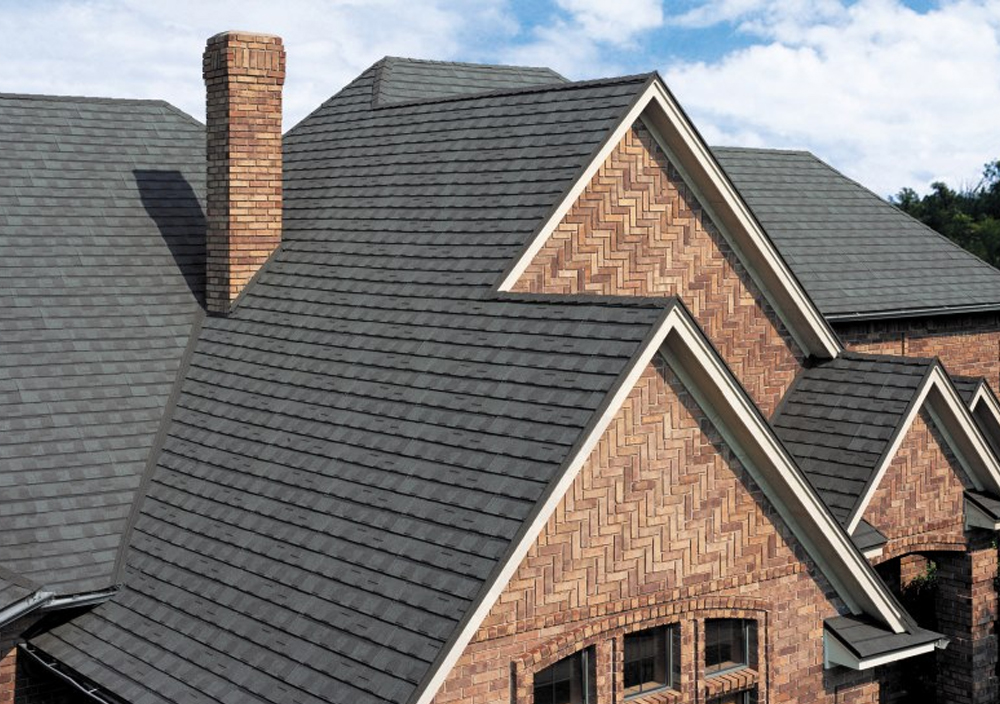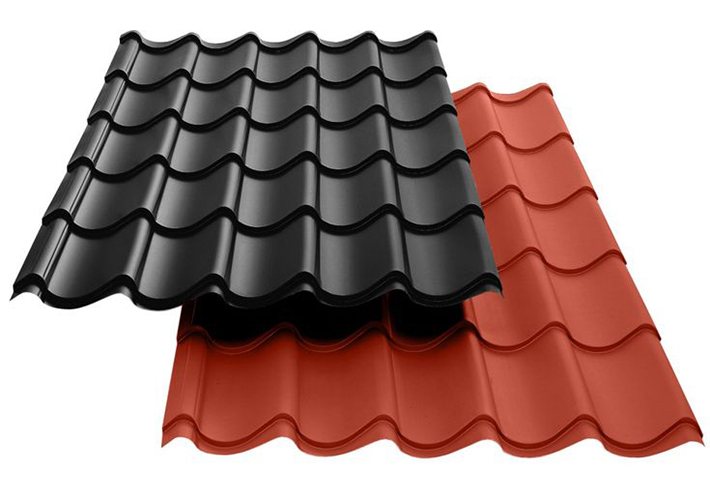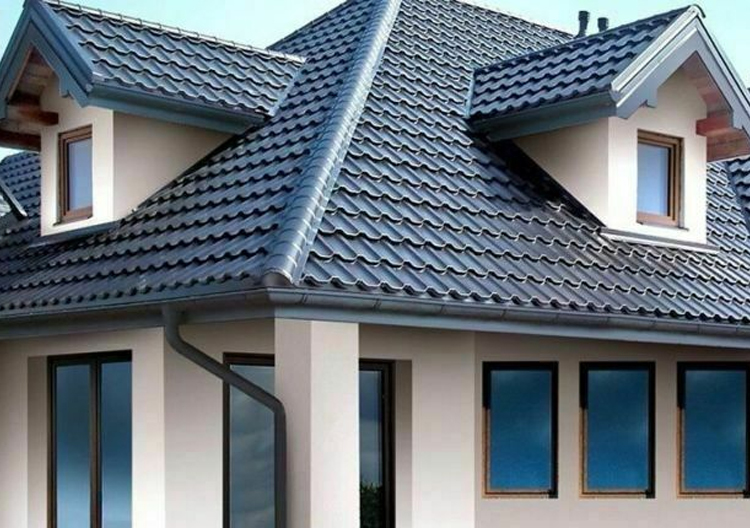Here’s a comparison between stone-coated roof tiles and color steel sheets to help you evaluate which roofing material may suit specific needs:

Material Composition & Structure
- Stone-Coated Roof Tiles:
- Core: Typically made from galvanized steel or aluminum-zinc alloy (Aluzinc), offering strong resistance to corrosion.
- Outer Coating: Covered with natural stone granules embedded in an acrylic polymer layer. This provides both durability and the appearance of traditional roofing materials (like clay tiles).
- Multi-layer protection: Includes layers like acrylic primer and base coats, enhancing its weather resistance.
- Color Steel Sheets:
- Core: Galvanized steel or Galvalume (GL) steel (aluminum-zinc coated steel) is the most common core material.
- Outer Coating: The surface is either painted or powder-coated with polyester or polyvinylidene fluoride (PVDF), which provides color and corrosion resistance.
- The sheet is typically thinner than stone-coated tiles and lacks the multi-layer protective system.
Installation Process
- Stone-Coated Roof Tiles:
- Installation complexity: They are generally installed over battens and require more specialized skills due to their weight and structure. The process can take longer than for steel sheets but provides a more secure and sturdy finish.
- Time investment: Requires precision to avoid gaps between tiles, especially in complicated roof designs.
- Roof Structure Requirements: Due to their weight, they may require additional reinforcement for certain roof structures.
- Color Steel Sheets:
- Ease of installation: Color steel sheets are much quicker and easier to install due to their light weight and large surface area. They can be cut and bent to fit various roof shapes.
- Time-saving: Can be installed directly onto rafters or purlins without the need for battens, speeding up the process.
- Roof Structure Requirements: Minimal structural reinforcement is needed due to their light weight, making them ideal for retrofitting existing structures.
Energy Efficiency
- Stone-Coated Roof Tiles:
- The stone granules reflect a significant amount of solar energy, reducing heat transfer into the building. This can contribute to lower cooling costs in warmer climates.
- The tiles also have air gaps between the roof deck and the tile itself, providing natural ventilation, which further enhances energy efficiency by reducing heat buildup.
- Suitable for cool roofs, contributing to overall energy savings and sustainability.
- Color Steel Sheets:
- The metal surface can become extremely hot under direct sunlight, transferring heat into the building and increasing the need for air conditioning.
- Some color steel sheets have special reflective coatings or finishes (such as cool roof coatings) to mitigate heat absorption, but they generally don’t offer the same level of insulation as stone-coated tiles.
- Reflective coatings improve energy efficiency to a degree, but insulation may need to be supplemented with additional materials like thermal insulation boards.

Weather Resistance
- Stone-Coated Roof Tiles:
- Wind resistance: Can withstand hurricane-level winds (up to 120-150 mph), making them ideal for regions with severe windstorms.
- Hail resistance: The stone coating helps absorb the impact of hail, reducing the chance of damage.
- Fire resistance: Non-combustible, providing a Class A fire rating (the highest rating for fire resistance).
- Corrosion: Due to the protective zinc-aluminum base and stone coating, these tiles offer superior resistance to rust and corrosion, making them suitable for coastal or industrial regions.
- Color Steel Sheets:
- Wind resistance: Can resist moderate to high winds, but may be susceptible to lifting in extreme conditions if not properly secured.
- Hail resistance: Prone to denting when exposed to hail. While some thicker sheets may resist damage better, they are still more vulnerable compared to stone-coated tiles.
- Fire resistance: Like stone-coated tiles, color steel sheets are non-combustible but may not always meet Class A ratings depending on the coating.
- Corrosion: Color steel sheets are susceptible to rusting, especially if the paint or coating is scratched or in coastal environments where salt air accelerates corrosion. Regular maintenance and coating are needed.
Lifespan & Maintenance
- Stone-Coated Roof Tiles:
- Longevity: Typically lasts between 40-70 years with minimal maintenance. The longevity depends on factors like climate, installation quality, and maintenance.
- Maintenance: Requires occasional cleaning and inspection for chipped or loose tiles but overall has low maintenance demands.
- Resistance to Moss and Algae: The stone coating can resist moss and algae growth to some extent, especially in humid climates.
- Color Steel Sheets:
- Longevity: Generally lasts 20-40 years, with lifespan highly dependent on the environment and the quality of the coating.
- Maintenance: Requires more frequent inspections for scratches, rust spots, and peeling paint. Corrosion-prone areas may need recoating over time.
- Moss and Algae: More prone to moss and algae growth, particularly in humid climates, which can affect its appearance and integrity over time.
Application & Usage
- Stone-Coated Roof Tiles:
- Commonly used in residential buildings where aesthetics, long-term durability, and weather resistance are critical.
- Popular in areas with extreme climates, including coastal, high-wind zones, or regions prone to snow.
- Suited for higher-end projects or homes looking to balance functionality with architectural style.
- Color Steel Sheets:
- Widely used in industrial and commercial buildings due to their cost-effectiveness, easy installation, and modern appearance.
- Also favored in warehouses, factories, and agricultural buildings, where functionality and speed of installation are more important than aesthetics.
- Suitable for low-slope or flat roofs, where quick installation and minimal structural support are necessary.
Cost Considerations
- Stone-Coated Roof Tiles:
- Higher initial cost: The cost of materials and installation is significantly higher compared to color steel sheets, but it’s considered a long-term investment.
- Cost of ownership: Over time, the durability and low maintenance of stone-coated tiles can result in cost savings.
- Color Steel Sheets:
- Lower upfront cost: Color steel sheets are more affordable, making them a popular choice for budget-conscious projects or temporary structures.
- Long-term costs: While cheaper upfront, color steel sheets may incur higher maintenance and replacement costs over their shorter lifespan.

Conclusion
- Stone-Coated Roof Tiles are best for high-end residential or commercial properties that require durability, weather resistance, soundproofing, and aesthetic appeal. Their higher cost is offset by long-term savings in maintenance and energy efficiency.
- Color Steel Sheets are ideal for industrial and budget-conscious projects, offering ease of installation and a modern look at a lower cost. However, they require more frequent maintenance and may have a shorter lifespan in harsh environments.
Choosing between these two materials depends on factors like budget, aesthetic preference, location (weather conditions), and the long-term goals of the project.





